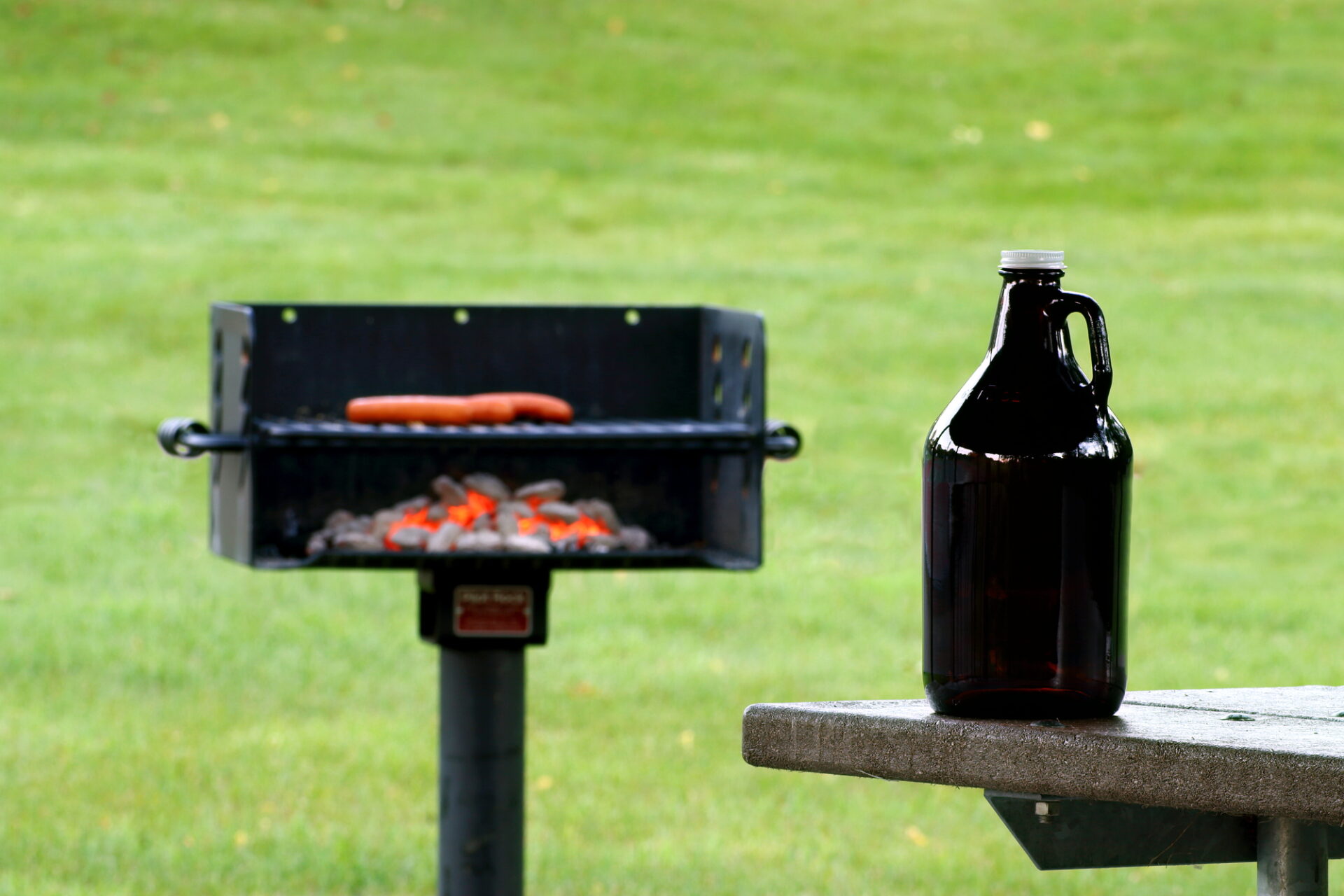If you have ever been sat in your favorite craft brewery tap room sipping on a delicious new IPA and wanted to take some home with you but they haven’t yet bottled it, maybe the barman has offered you a growler to take some home in (or even a howler). Perhaps you even have your own growler in the trunk of your car ready for such occasions – as a Boy Scout I was always taught to be prepared, although I’m not sure that extended to taking beer home with you!
A growler, and to some extent a howler, is the ideal way of sharing some of your favorite beer with your beer-drinking buddies, or even taking some home to your beloved wife (although, admittedly, there won’t be too much to share with a howler)!
A more recent development is the crowler, which is now found in many tap rooms across the nation, a way for beer drinkers to take home a sealed oversized can of their favorite fresh beer straight from the tap.
How did growlers first come about? Why are they even called a growler? What is a howler and what exactly is the recent innovation of a crowler? How much beer does each popular takeaway container hold, and how long will the beer stay fresh?
Growler vs Howler vs Crowler at a Glance
| GROWLER | HOWLER | CROWLER | |
|---|---|---|---|
| Capacity | 64 oz | 32 oz | 32 oz |
| Material | Glass, ceramic or stainless steel | Glass or rigid plastic | Aluminum |
| Reusable | Yes | Yes | No |
A Brief History of the Beer Growler and How the Growler Got Its Name

The origins of the beer growler can be traced back to the late 19th Century when patrons of local bars would use vessels such as tin pails, a pitcher, and glass bars or jugs to carry beer home with them. The most common beer vessel used was a 2-quart galvanized bucket or enameled pail with a loose-fitting lid.
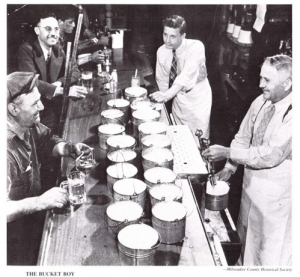
It’s thought these metal buckets got their name “growlers” from the growling-like sound made by the carbon dioxide escaping from the lid as the beer sloshed around inside the pail. Other sources argue the growling refers to the sound made by patrons as the bartender filled their two-quart pail if they felt they were not getting the full measure!
Prior to Prohibition, women and children would often bring these covered buckets of beer from the local brewery or pub to factory workers at lunchtime or home for the evening meal. This practice became known as “rushing the growler” with the growler name already stuck for the containers. Adults who often made a living carrying the buckets would be called “bucket boys” or in Milwaukee “Kesseljunges”, a German term used by the local German immigrants.
In the years leading up to Prohibition the “bucket trade” would often be attacked by the anti-alcohol “temperance” movement, which resulted in the 18th Amendment (the total prohibition of all alcohol). Laws were passed in many states which regulated or completely banned the bucket trade and the use of growlers. Many of these laws were only repealed or relaxed in the last 20 years or so. For example, in North Carolina, only breweries were allowed to fill a growler, with bars and retail stores only being allowed to refill the growler since 2013.
By the 1950s, the tin pails used as growlers had virtually been phased out, and instead bars and breweries would use waxed cardboard containers with lids that would look like a cross between a milk jug and a Chinese takeaway soup container. In the 1960s, most bars would switch to plastic and were allowed to sell pre-packaged beers after hours, so the idea of a beer growler slowly disappeared.
It was only with the advent of the craft beer scene in the US that growlers made a comeback. Many small microbreweries such as Otto Brother’s Brewery in Wyoming couldn’t afford the beer bottling equipment and machinery to bottle their delicious beers.
Charlie Otto is often credited with the revival of the growler as his father remembered the use of the growlers in his younger days. However, Charlie felt the packaging needed updating so Charlie began silk-screening the Brewery logo on half-gallon glass jugs, and the growler as we know it today was born.
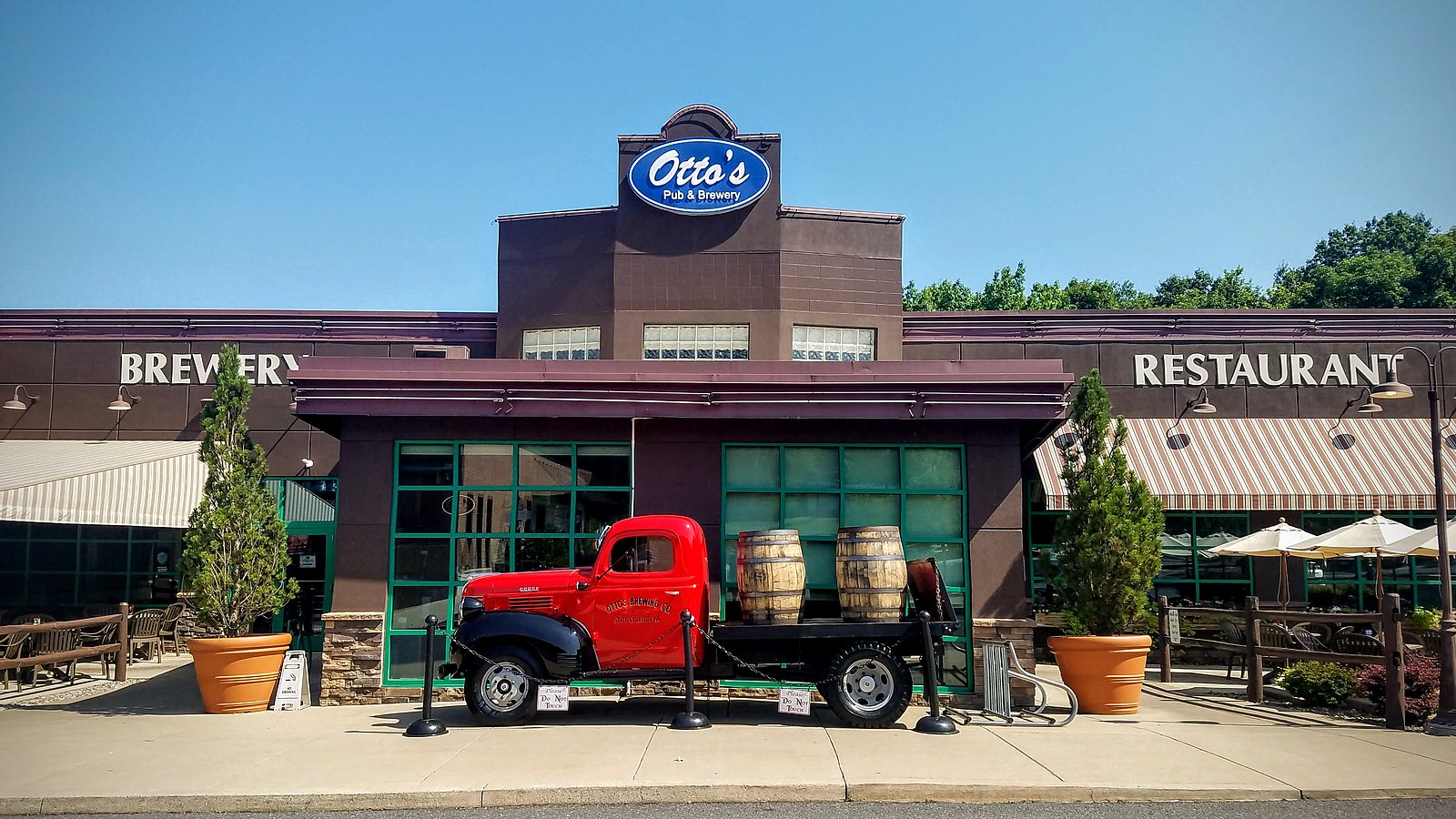
The Benefits of a Growler
It’s very rare nowadays to visit a tap room that doesn’t have a stock of growlers behind the bar. The growler offers the ultimate way to take a larger amount of your favorite draft beer home with you without having to buy a keg or a mini keg.
Traditionally a standard 64-ounce growler holds just over 5 standard 12 oz servings. The growler sizes offered by some microbreweries include 128 oz growlers, but these are much less portable and often contain too much beer to consume in one session without the beer spoiling. If you’re having a larger social gathering of craft beer lovers, why not see if your local craft brewery can supply a keg or at least a restaurant-size mini-keg?
I know that if I’m having a backyard cookout in the summer months I often pick up several growlers of different types of beer to cater to the tastes of my beer-drinking buddies. A standard-size glass growler is also the perfect size to fit in the refrigerator to keep the beer cold. Any larger and it would struggle to fit in most domestic refrigerators.
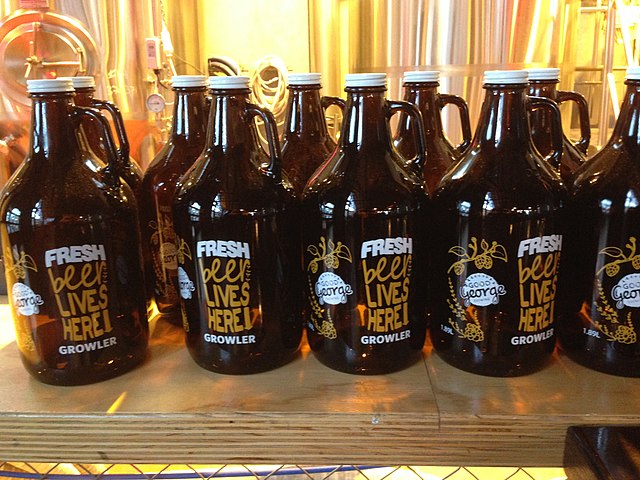
The beer growler offers many benefits including:
- Easier transportation of beer. You can take growlers almost anywhere with you, from that weekly fishing trip, a hunting weekend, a day out with a picnic, or even on short camping trips. Most are not too heavy, and a convenient handle on the side or top of the growler makes them easy to carry – certainly much easier than transferring six-pack cans of beer in and out of your bag. Their size means you could even pack several normal growlers in the trunk with the air-tight caps keeping your beer fresh for days.
- Bringing craft beer home from your favorite brewery. Maybe your local craft beer bar hasn’t got around to bottling or canning your favorite draught beer or the newer special releases yet, in which case a growler allows you to take some home with you. Always check if your local brewery reuses growlers before buying one of your own generic growlers. Due to sanitation issues, some craft breweries won’t fill growlers brought in from outside.
- Sharing your homebrew with buddies. Bottling a growler with your latest homebrew creation is the perfect way of sharing with friends, family, and other beer enthusiasts, wherever they may be.
- Allows for tapping a new keg. If you are hosting a party and you feel the keg is getting empty, growlers are the perfect way of running off the remaining beer into a container that will keep it fresh so that you can tap the next keg for an uninterrupted flow of beer. I remember that we used to try and quickly drink the remaining beer in a keg to make way for a new one, which is okay if there are only one or two pints left, but drink 64 fluid ounces or more of beer too quickly and you won’t be tapping too many more kegs that night!
- Advanced protection for your beer. More recently, some growler manufacturers have started producing double-walled stainless steel growlers which provide extra insulation for keeping your beer cooler and improving the beer’s durability over an extended period.
- Easy to maintain. Growlers can be very easy to clean – normally it’s enough to rinse with warm soapy water once they are empty and then sterilize with some of your leftover beer sterilizer fluid. Some of the newer growlers are even dishwasher friendly for the ultimate convenience, but you should always let a growler air dry rather than adding the risk of contamination from a tea towel or other drying cloth.
- More environmentally friendly. Rather than throwing away regular beer cans or bottles after you have drunk your beer, the growler is reusable and the most sustainable option.
Different Types of Growlers
Growlers come in many different shapes and colors and most importantly are made from different materials. Glass is perhaps the most common and traditional of the newly born growler, but you will also find them in stainless steel, ceramics, and even rigid plastic.
Glass Growlers
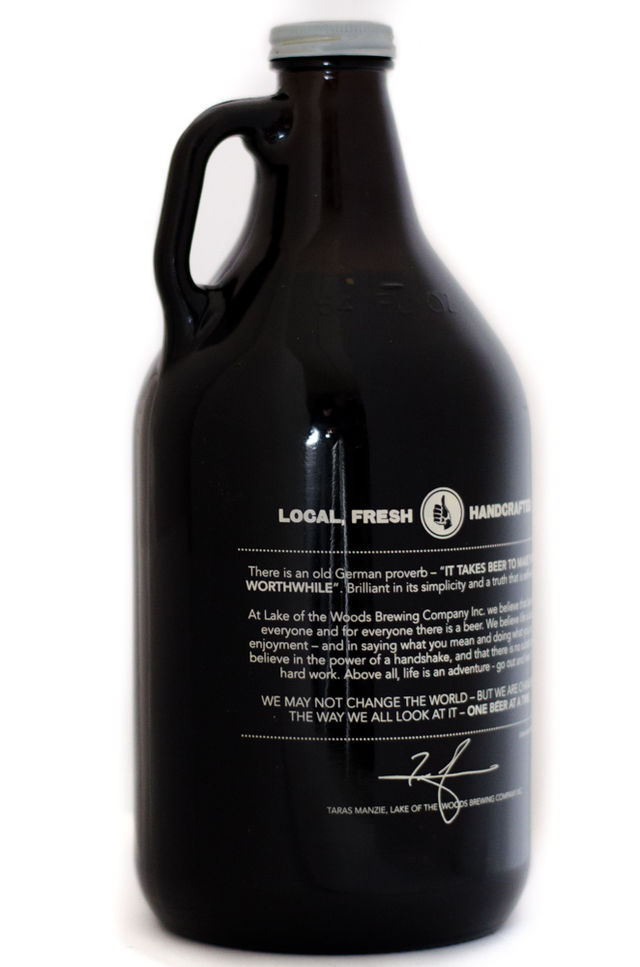
Glass is definitely the most traditional material for a growler and can be made of either smooth or ribbed glass. Normally they will be made of clear or brown glass.
Although a transparent glass growler of beer allows you to see the beer inside, it offers no protection to the beer from sun exposure and the beer can develop those skunky “sun-struck” flavors and aromas we try to avoid. But on the other hand, darker glass will absorb the heat of the sunlight quicker, which you definitely don’t want with lagers that become warm too fast. Consider what type of beer you are going to put in the growler before choosing a color.
The main downside of a glass growler is its fragile nature. A glass growler can quickly shatter or crack while handling them. Another possible problem is with bacterial growth, especially when filling from the tap or when the bottle cap is damaged or bent. Due to the shape of most glass growlers, as oxygen enters the container and carbon dioxide exits, the beer will spoil in a shorter time after taking your first pour.
Ceramic Growlers
You may have a problem finding this type of growler, although if you do find one they make the perfect gift for the beer lover in your life. They are the most attractive but also the most expensive type of growler on the market. They can be more difficult to clean and also too heavy to carry around as easily. Unfortunately, just like a glass container, a ceramic growler will break easily if dropped by accident and unlike glass, you can’t see inside to determine how much beer is left.
However, the ceramic growler is a thing of beauty and one deserving of the most special beers.
Stainless Steel Growlers
The trendiest type of growler you will often see nowadays is the stainless steel growler sported by many of the adventure outdoorsy types. It’s a more durable growler you can carry around without fear of it breaking if you should accidentally drop it. The stainless steel also insulates the beer and keeps it colder than other materials, and the opacity of the growler offers the ultimate protection of the beer from light. On the downside, it also means you can’t see how much amber nectar you have left to drink.
Some stainless steel growlers, like the excellent uKeg growlers, are even pressurized to help keep the beer carbonated and stay fresh longer. They are almost a mini-keg that you can easily carry on that next camping trip.
- STAYS FRESH - patented carbonation system automatically maintains freshness and optimal carbonation for weeks
- STAYS COLD - double wall stainless steel vacuum insulation keeps beverages cold all day
- STAYS CARBONATED - streamlined regulator cap allows you to choose high or low carbonation setting to match the beverage you're serving
Plastic Pet Growlers
Looking like an oversized soda bottle from 7/11, this sturdy growler is an ideal option for beer for carry-outs as it’s cheap, durable, and lightweight. Normally using brown plastic, they will also offer protection from UV light to the beer and extend the shelf life.
Unfortunately, they may not be as durable as glass containers and can wear out much quicker, cleaning too vigorously can often leave micro-abrasions in the plastic where beer-spoiling bacteria can live, and a beer aficionado would argue plastic bottles give the beer a plastic-like chemical taste over an extended period. They may be okay for filling with a domestic lager, but if you have an awesome beer then you’ll want an awesome beer container to keep it in!
What is a Howler?
So far, I have only discussed beer growlers and the different sizes of growlers available. But what exactly is this similar phrase you may have heard about – the howler?
Basically, a howler is a baby growler coming in with a capacity of just 32 fluid ounces compared to the 64 fluid ounces of a standard growler. It contains the equivalent amount of just under 3 standard 12oz beer bottles and is much lighter and more portable than a growler.
The name howler originates from the mix of half and growler. Howlers are compact, lightweight, and easy to carry, making them perfect for outdoor activities or when you want to enjoy a beer on the go.
They came in generally the same materials as a full grown-up growler, although plastic howlers are more common due to the lower cost involved. As a smaller container, they can be much cheaper to fill with beer and hold just enough beer for your average craft beer drinker to take home at the end of the night.
Some breweries may not offer all their beers in howler sizes, preferring instead to sell a few cans or bottles of other beers, so your choice may be limited compared to the average craft beer growler.
How Long Does Beer Stay Fresh in a Howler or Growler?
Once you open your growler, your beer will start to lose its carbonation. On the first day of opening the beer will remain fresh, but it can go flat quite quickly. Even if you recap the beer, for a standard growler you should aim to drink the beer in 24 – 48 hours.
There are several other factors that can affect how long you should keep beer in your growler, including the type of beer, the filling process, the type of growler, whether the growler is pressurized or not, along with factors such as the storage of the growler – I have taken a more though in-depth look at in my post “How Long Does a Growler Last Unopened?”
The Crowler – The Evolution of a Beer Growler
A more recent development in take-home beer containers is the innovation of the crowler developed by Oskar Blues Brewing, a leading exponent of canning in craft beers.
Developed in 2013 by Oskar Blues in partnership with the Ball Corporation, they developed the first system for canning and sealing a 32 oz beer behind the bar, just like filling a growler. Basically, a crowler is a 32 oz howler holding 2 pints of beer, but in an aluminum can similar to the prepackaged beers you find on the shelves of your local grocery store and supermarkets.
After its initial early success, Oskar Blues made the technology available for purchase by other brewpubs and microbreweries, and there are now several manufacturers of this canning-plant-in-a-box machinery, allowing Dixie Canner Co and October, in addition to Oskar Blues, to offer a variety of crowler machines for sale.
You will quite often see Crowlers at many of the larger beer festivals giving festival goers a way of taking home more beer.
When it is compared to a traditional glass growler, the crowler offers several distinct advantages.
- An airtight seal from the lid of the can being crimped on filling means there are no issues with cap leakage or oxygen permeating the beer.
- No sunlight can penetrate the crowler and risk altering the flavor of the beer, as often happens with glass vessels.
- Crowlers are stocked by the bar, there’s no need to be carrying empty growlers in your car trunk.
- No glass to worry about breaking if you should accidentally drop the crowler.
- The most amazing can of shotgun beer ever!
Crowlers keep your beer fresher for longer periods, which appeals to both craft beer drinkers and brewers alike. They are also much more portable and easier to ship than similar glass containers.
However, crowlers are not reusable – once they’re empty you simply throw them away. A crowler is recyclable though, so it can be more sustainable than many of the disposable traditional beer cans. Also, there is no way of resealing a crowler once it’s opened, so all the beer should be consumed in one serving to enjoy it at its best.
Howler vs Growler – Final call
Hopefully, you now have a clearer understanding of what a howler is compared to a growler. They are both reusable containers that can be used for carrying home your favorite beer from the bar or brewery to enjoy at home or on your next trip out, be it a picnic, a fishing day, or a camping trip.
The only difference between a howler and a growler is the size. Think of the howler with its 32 oz capacity as a baby growler, with the growler holding double at 64 oz of beer or sometimes even 4 times as much with the rarer 128 oz growlers.
I personally prefer the size of a growler – after all, more beer is always better. However, if you are wanting to share some of your homebrew with friends then personalized howlers can be a much more unique and personal touch than just using 3 generic beer bottles!
Whichever you choose, remember a growler or howler will only keep the beer fresh for a limited period, and once opened, it’s best to consume the beer within a day or two at max. Unless, of course, you are lucky enough to have been treated to, or even treated yourself to, a pressurized growler/minikeg like the uKeg.
If you want a beer that will keep for longer periods of time, then see if your bar offers a crowler – basically an oversized aluminum can of beer. Again, this will need to be drunk quickly once opened as you can’t reseal the can, but to be honest, that’s not really a problem when it’s filled with my favorite IPA!

